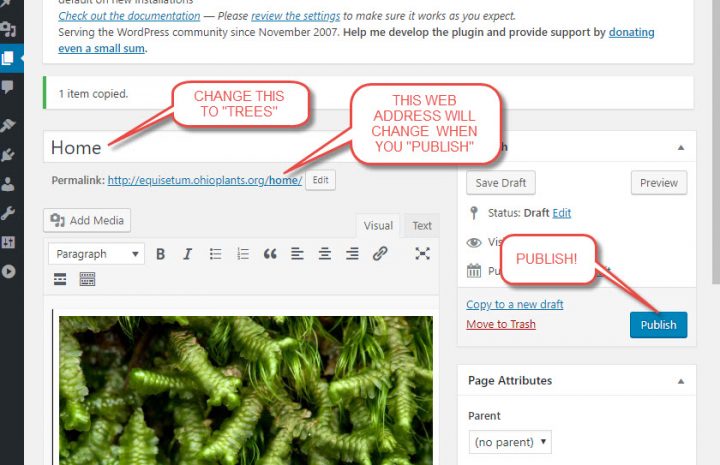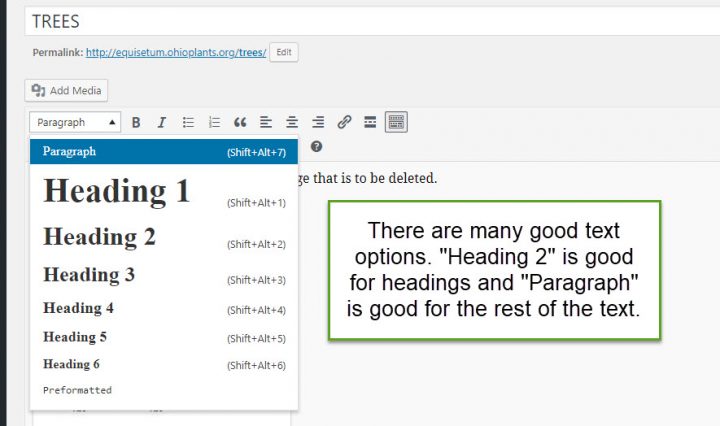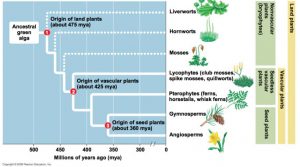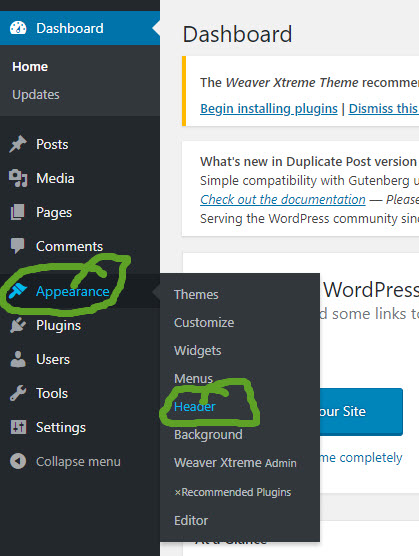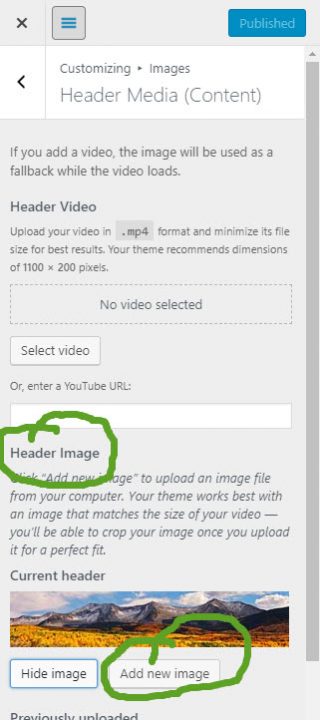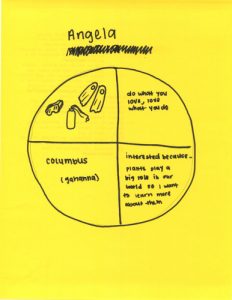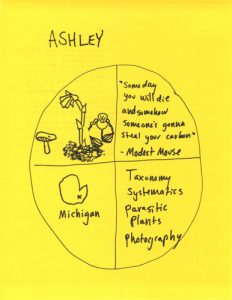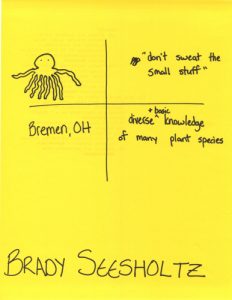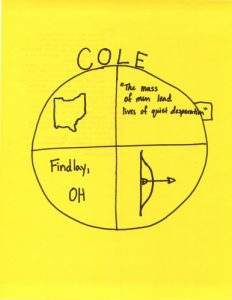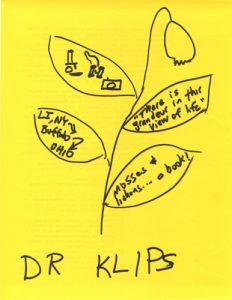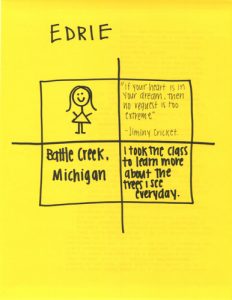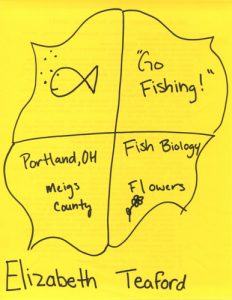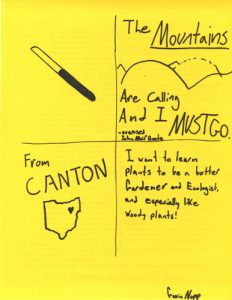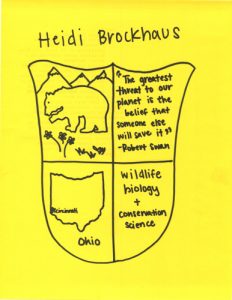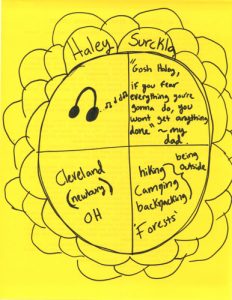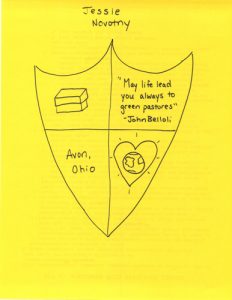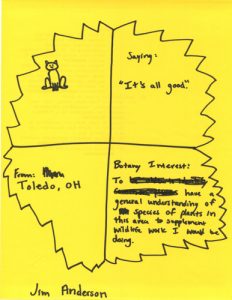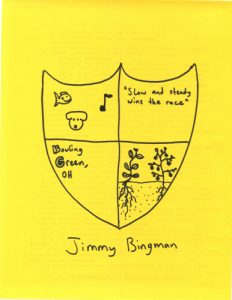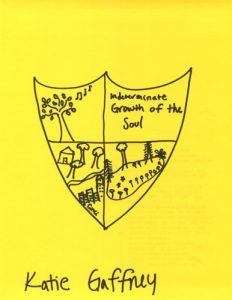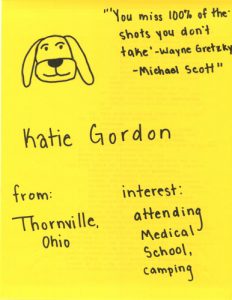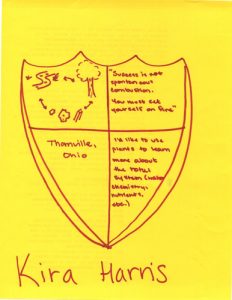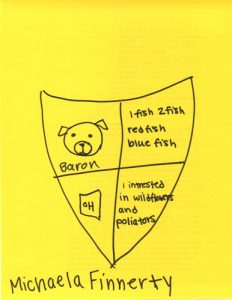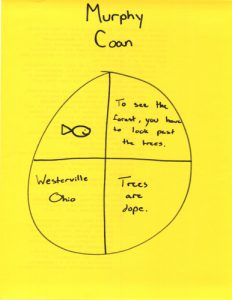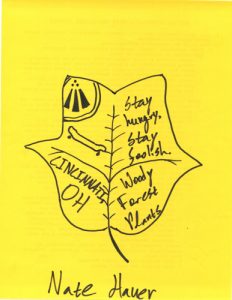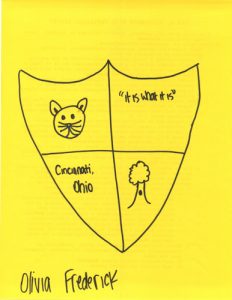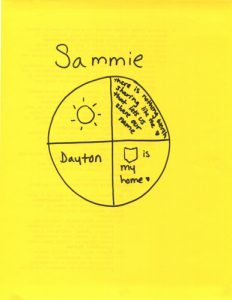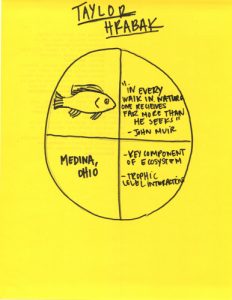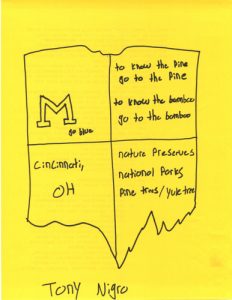BOTANICAL SURVEY WEB PAGE UPDATES
(15 pts. total)
CRYPTOGAMS (Mosses and Lichens) (5 pts.) COEFFICIENTS OF CONSERVATISM (10 pts.)
PART ONE: BOTANICAL SURVEY CRYPTOGAMS
(MOSSES AND LICHENS) (TWO EACH)
MOSS SAMPLES BROUGHT TO
“FIELD EXPERIENCE” OCTOBER 3/4
At your site you probably have a number of mosses and lichens growing. For TWO MOSSES, if it is possible for you to non-destructively collect a small (less-than-finger-sized) piece of moss (enough for lab identification), grab some and bring them to lab this week. If you CANNOT gather moss from your field sites, get them from some other location –any other location. At least one of the mosses needs to be new (not one of the 8 we learned in class). This ought to be fun!
For LICHENS, let’s not collect them (because lichens are too slow growing and often are tightly adherent to the substrate). ID them in the field using your “Common Lichens of Ohio” field guide with the wonderful amazing spectacular terrific photos and snap your own pics. Post them on your “Plants of ____” web page. This ought to be fun!
PART TWO: BOTANICAL SURVEY UPDATE: FOUR HIGH CC AND FOUR LOW CC SPECIES
WEB SITE UPDATES DUE OCTOBER 6
Now that you’ve been to your botanical survey site a few times and have a good idea what is there (and have started your written report …right??) the world is keen to hear more of what you’ve discovered! Let’s get some practice using the coefficients of conservatism (CC) assigned to each species by Andreas et al. (2002). The CC, with values ranging from 0 to 10, is an estimate of the degree to which a species is associated with high-quality natural communities similar to those which existed in pre-settlement times. Exotic (alien, introduced) species are not assigned CC values.
CC values for all of Ohio’s plants can be found in the Ohio Environmental Protection Agency’s web site. Click on the image below to navigate to the Ohio EPA reports page which includes the CC/FQAI material.
Scroll down on the EPA page to access the Floristic Quality Assessment Index (FQAI) materials. This include the following:
The original FQAI REPORT published in 2004, also available as a direct download HERE (link).
An excel SPREADSHEET published in 2004 using older species names that may in fact be consistent with our older field guides, also available HERE (link).
An html version of 2014 update of the spreadsheet available HERE (link).
Set forth on your web site the list of species you found at your site, along with the CC value for each. Also, compute the Floristic Quality Assessment Index for ther entire site using the formula given in Andreas et al. (2004).
Using the CC data in either of these sources, look over the list of species you have compiled for your site. Select TWO OF YOUR HIGHEST CC (conservative) species and TWO OF YOUR LOWEST CC species (weedy plants, essentially). Provide photographs, descriptions, and natural history facts about each of them.
BOTANICAL SURVEY WEB-PAGE LAUNCH
GET POISON-IVY
Due Sunday September 29 (credit 15 pts.)
Hats off to everybody for picking a great site for your botanical surveys! For this assignment, let’s start a new page devoted to the botanical survey called “Plants of ___” (fill in the blank). Add the following content:
- A paragraph describing the site.
- A map showing the location of the site.
- Plants! Provide both common and scientific names, the latter written properly in terms of capitalization and italics. Photo-document two new trees, two new shrubs or woody vines, and two flowering or fruiting plants that can be identified to species.
- For at least 4 of the plants, include some interesting “fun facts” about their natural history such as human uses for the plant, animal interactions (host plant for certain moths, for example), conspicuous floral displays, etc.
- One more thing; get poison-ivy! Oh, I don’t mean it that way. Locate some (either at your survey site or elsewhere), photograph it, and set forth the features useful in identifying the nasty stuff.
FIELD TRIP ASSIGNMENT PART 2
MARSH, PRAIRIE AND FEN
(CREDIT: 30 PTS. DUE WEDNESDAY SEPT. 25)
Great work at the marsh, prairie and the fen! The blogging assignment for this week will be a 30 point second part of the combined “Field Trips” page worth 60 points. Please do the following.
Add a new Heading to your “Field Trips” page, called “Marsh, Prairie and Fen” and add the following content:
- MARSH. Give a brief description of the marsh we visited along Darby Creek Drive. Mention the dominant plants of each growth form we saw there (i.e. woody plants, herbs, and weeds) and at least one labelled plant image you took.
- PRAIRIE. Give a brief description of the restored tallgrass prairie we visited at Battelle Darby Metro Park. Mention the dominant plants of each growth form we saw there (i.e. woody plants, herbs, and weeds) and at least one labelled plant image you took.
- CEDAR BOG THAT ISN’T A BOG. Give a detailed description of the Cedar Bog hydrology and explain the differences between bogs and fens, and why Cedar Bog is perhaps misnamed. Describe the unique ecological conditions there and what causes them (geology). Below, see some of the interpretive material that on display at the nature center. Set forth the most important part: the discoveries you made fulfilling the “scavenger hunt” assignment (in most cases two plants that met certain criteria). For the two plants, include your PHOTOS of the plants, how to recognize them, and at least one additional outside reference natural history fact about each plant.
- Yippee!
- Please complete this PART 2 by Wednesday September 25.
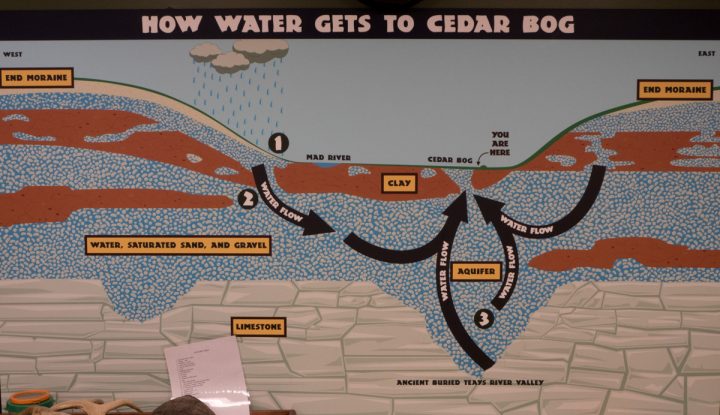
How water gets to Cedar Bog
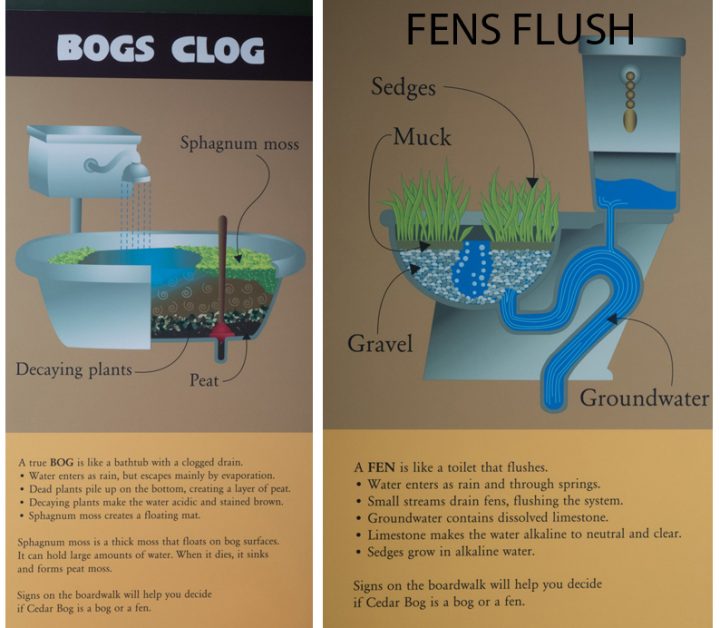
Bogs clog and fens flush.
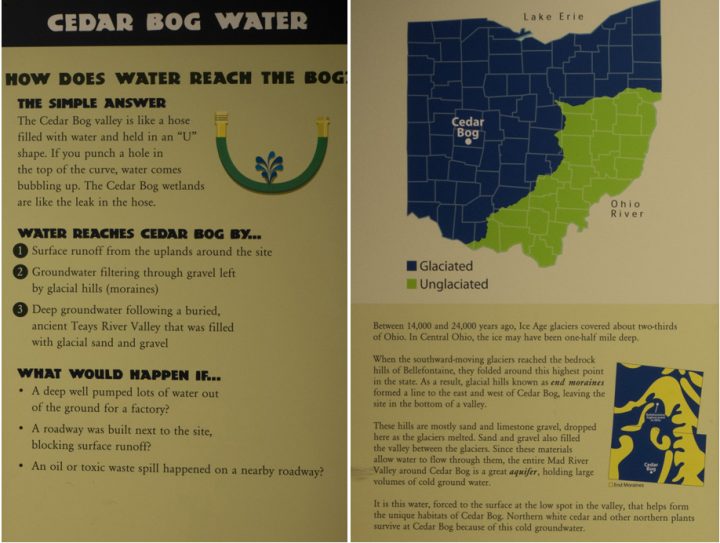
CEDAR BOG HYDROLOGY and OHIO GEOLOGY
Additional information about Cedar Bog that isn’t a bog can be seen in the 1974 Ohio Journal of Science article by Clara May Frederick that can be read and downloaded HERE (link).
FIELD TRIP WEB ASSIGNMENT 1
(credit: 30 pts due Friday September 20)
On our amazing field trip to Deep Woods we saw many things, including an outhouse with a view, the Appalachian Gametophyte, sword moss, butternut, American chestnut, and many many ferns! Each of you were given a web site/blog assignment that pertains to one aspect what we saw there. Please do the following to earn 30 pts. and spread the word about botany!
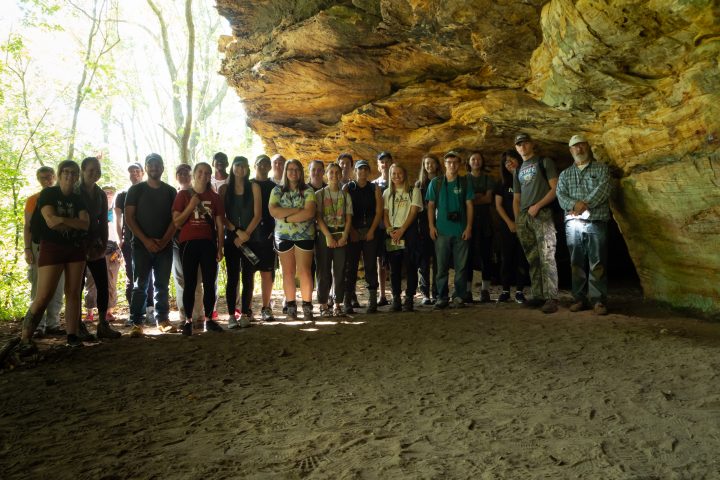
What a classy class, eh?
Create a new “FIELD TRIPS” page (by cloning a previous page so that you have one column, no sidebars, no comments, etc), and make a heading called “Deep Woods, the Appalachian Gametophyte, and Ohio Geobotany.”
- For your individual web site/blogging assignment, insert the relevant photo(s) of your plant assignment with a caption and state what plants are beings depicted, and what features. Provide some additional natural history/ecology information about the plants and the feature you are describing.
- Read the article “Linking Geology and Botany: a new approach” by Jane Forsyth handed out in class on Thursday and answer the questions that accompanied it. In addition to being written, the answers should be incorporated into your web site/blog coverage of the Deep Woods Trip.
- Set forth 4 instances of plants that that you observed on our field trips that are consistent with the patterns that Forsyth explains with respect to acid sandstone places like the Hocking Hills (Deep Woods) compared with an eastern Ohio calcareous site (next week’s field trip to Batelle Darby Metro Park and Cedar Bog that isn’t a bog).
-
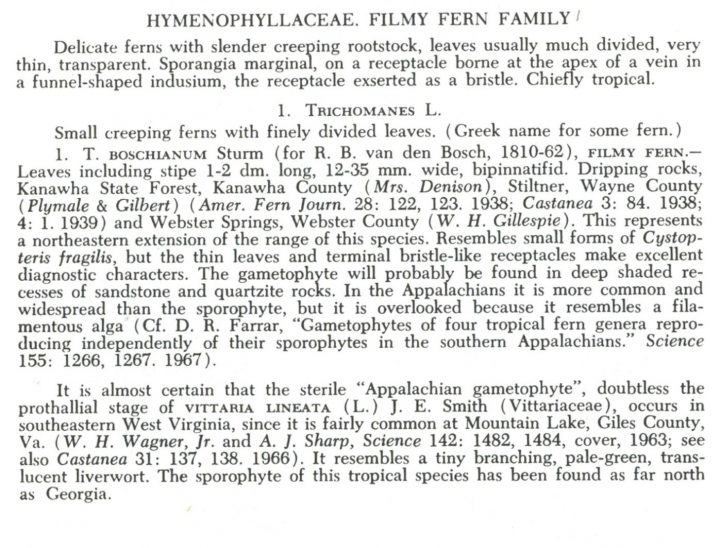 Doubtless? The excerpt above is from “Flora of West Virginia,” by P. D. Strausbaugh and Earl L. Core Flora of West Virginia originally published in four parts, beginning with part one in 1952 and ending with part four in 1964. A group of six botanists from West Virginia, Maryland, and North Carolina is updating the book for future publication. Imagine that you are hired to write the description of the Appalachian gametophyte for the new edition. After reading the American Journal of Botany article “Unraveling the Origin of the Appalachian Gametophyte” (Pinson and Schuettpelz, 2016), what will you write? How would that differ from the above? Describe the environmental conditions at Deep Woods where we saw the Appalachian Gametophyte.
Doubtless? The excerpt above is from “Flora of West Virginia,” by P. D. Strausbaugh and Earl L. Core Flora of West Virginia originally published in four parts, beginning with part one in 1952 and ending with part four in 1964. A group of six botanists from West Virginia, Maryland, and North Carolina is updating the book for future publication. Imagine that you are hired to write the description of the Appalachian gametophyte for the new edition. After reading the American Journal of Botany article “Unraveling the Origin of the Appalachian Gametophyte” (Pinson and Schuettpelz, 2016), what will you write? How would that differ from the above? Describe the environmental conditions at Deep Woods where we saw the Appalachian Gametophyte.
FOUR FLOWERS and FOUR FRUITS WEB PAGE ASSIGNMENT
Due Sunday September 21 (credit 30 pts.)
This week we will apply and extend the flower and fruit analysis skills that we learned last week. Go out into the world and discover 4 wild (not cultivated) plants in flower and 4 wild (not cultivated) plants bearing fruit for a total of 8 different plants. Identify the FLOWERING species using your Newcombs Wildflower Guide. Photograph each one, several images per plant of you wish.
The 4 flowering plants must each belong to a different family. The four fruiting plants must each be a different fruit type,and be different species than your flowering ones.
Make a new web page titled “FLOWERS AND FRUITS” by cloning your home page so that you get a single column, no sidebars page layout. Provide the following information about each plant along with the photos:
- common and scientific names for the flowering species, the latter written properly in terms of capitalization and italics and the plant family each belongs to.
- a description of the flower in terms of the features we covered in class: symmetry, fusion of parts, numbers of parts, relative insertion of flower parts (hypogyngous, perigynous or epigynous), gynoecium type (unicarpellate, syncarpous, or apocarpous).
- where you saw the plant
- what type of inflorescence the plant has (for all 8 plants)
- have fun with this; be creative!
EEOB 2210 LOCAL FLORA CLINTONVILLE RAVINES BOTANICAL SURVEY
Effective stewardship of natural areas depends upon an accurate accounting of the biotic resources, particularly the vegetation, present on a site. The development of a site-specific plant species list, along with a written description of the plant communities that are there (including relevant information about the human and natural ecology of the plants) is often desired by natural resource agencies, landowners, and environmental organizations. This substantial (100 point) assignment is to perform and document a botanical survey like the ones performed by professional field botanists engaged in environmental assessment. The specifications for this project are here (link to .pdf)
BOTANICAL SURVEY INSTRUCTIONS
SAMPLE BOTANICAL SURVEY
HERE ARE THE SITES
(touch-screen navigate using 2 fingers)
DENDROLOGY (trees) WEB PAGE ASSIGNMENT
Due Sunday, September 1 (credit 20 pts.)
Tree Assignment Content Guidelines: For context and inspiration, read this article in a recent New York Times (LINK). Cite and expand upon the points that Popkin makes in your tree page. Isn’t it a nice coincidence that the species illustrated –eastern redbud (Cercis canadensis) –is the same tree we started off our trees lab with? Great minds work in similar ways.
This week we will apply and extend the tree identification skills that we learned last week. Go out into the world and discover 8 wild (not cultivated) broad-leaved (not conifer) trees. Identify them to species using your Peterson’s Field Guide to Trees and Shrubs. At least half of them must belong to different genera than the 8 we learned in class. Photograph your 8 trees close enough up (close up enough?) (up close enough??) (up with enough closeness???) to see the features that allow it to be recognized for what it is. Provide one or two photos of each tree –perhaps one showing the overall shape and form, and definitely one showing leaf details.
Provide the following information about each tree:
-
-
- common and scientific names, the latter written properly in terms of capitalization and italics.
- a written description of the pertinent identification features: leaf arrangement, complexity, and other traits that, taken together, distinguish that particular species.
- where you saw the tree, both the site locations and the habitat (the type of environment, i.e., swamp forest).
- for each tree, provide at least one interesting statement about the tree’s human or natural ecology that you hadn’t known before. Mention the source of your information and, in the case of internet sources, provide a hyperlink to that source.
- have fun with this; be creative, and be sure to compare your experiences with the ones recounted by Gabriel Popkin in the “Tree Blindness” article you read.
-
Tree Assignment WordPress Guidelines: We want pages (not posts) and we want those pages to be formatted neat and simple just like our HOME page (single column with no sidebars; info bar hidden; page title hidden; comments and trackbacks not allowed). Therefore please do NOT create a fresh new page for each new topic. Instead, “clone” your HOME page, and rename it, as follows.
Clone your home page by using the “Copy to a new draft option at the top of the page while you are in “edit” mode. (Note: this can also be done in the “Pages” section of the Dashboard, but this way is a bit simpler.)
Change the name of the page and it will automatically change the URL (“permalink”) to whatever you named it, in this case, “TREES.” Don’t forget to “Publish.”
Delete what’s there and add new stuff being sure to use the text selection options (Header 2 for headers and Paragraph for everything else works well.) Note the options for boldface, italics, and the ability to add links.
Adding media (photos) is pretty easy; just click the “Add Media” button and find the photo you want to add.

Add Media.
You can upload photos of any size (pixel dimensions) and WordPress automatically creates a set of lower-resolution versions. Note the options displayed on the right-hand side of the media page. In most instances, you will want to use “Large” size (800 px wide), centered. You can add a caption when you upload, or afterward while you are editing your page.
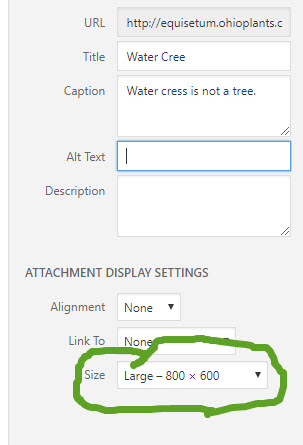 WEEK 1 LECTURE REVIEW MATERIAL
WEEK 1 LECTURE REVIEW MATERIAL
INTRODUCTION TO THE PLANT KINGDOM
WEEK 1…LAUNCH WEB SITES
Due Thursday (evening) August 29 (credit: 10 pts.)
Let’s begin this adventure by launching our web sites. Your web site is a subdomain of this very web site (www.ohioplants.org). The Universal; Resource Locator (URL) for your site is the genus of one of our favorite plants (dot) ohioplants.org. For convenience, see below, where there are links to your sites. To EDIT your site, simply enter into the browser bar your site name with “/wp-admin” added to it. To log in, enter the username and password you were sent in a recent email. Welcome!
Personalize your HOME page:
Add a header image and introduce yourself!
Header image. Navigate Dashboard -> Appearance -> Header. Take or obtain a photo you like, crop/resize it to the recommended pixel dimensions, and put it in place of the beautiful mountain scenery that sadly doesn’t look anything like Ohio. (Details below.)
Add a new image, following the prompts. The image adding procedure allows cropping, so the header picture doesn’t have to already be 1100 x 200 pixels, but you might want to start with an image with those dimensions.
Introduce yourself on your homepage. The editor has two options –“visual” and “text.” “Visual” is quite WYSIWYG and works like a word processor, and is the mode you’ll probably always use unless you really like hypertext markup language. Delete the text that is currently on your home page. Please do not delete this page and make a new one, but rather edit (i.e., add content to) this page.
Interpret/explain your “coat of arms.” Add a few fun biographical tidbits (or many, if you are so inclined) to this page. Suggestions: your academic and personal interests and career goals, your favorite plant, aspects of the natural world that most interest you, a definition of “Botany,” what you hope to learn from this class, etc. Have fun with this!
Clone your HOME page when you make new pages.
Note: For all the succeeding web assignments, you will make separate pages (PAGES, not POSTS!) by going to “all pages” on the dashboard (two little pages icon) and creating a “clone” of your home page. Because the home page is formatted in the preferred manner (one column, no sidebars, no comments), please do not create new pages from scratch. Instead, clone your homepage, rename it, and replace what’s there with your new content.
Again, for all the succeeding web assignments, make separate pages (PAGES, not POSTS!) by going to “all pages” on the dashboard (two little pages icon).



